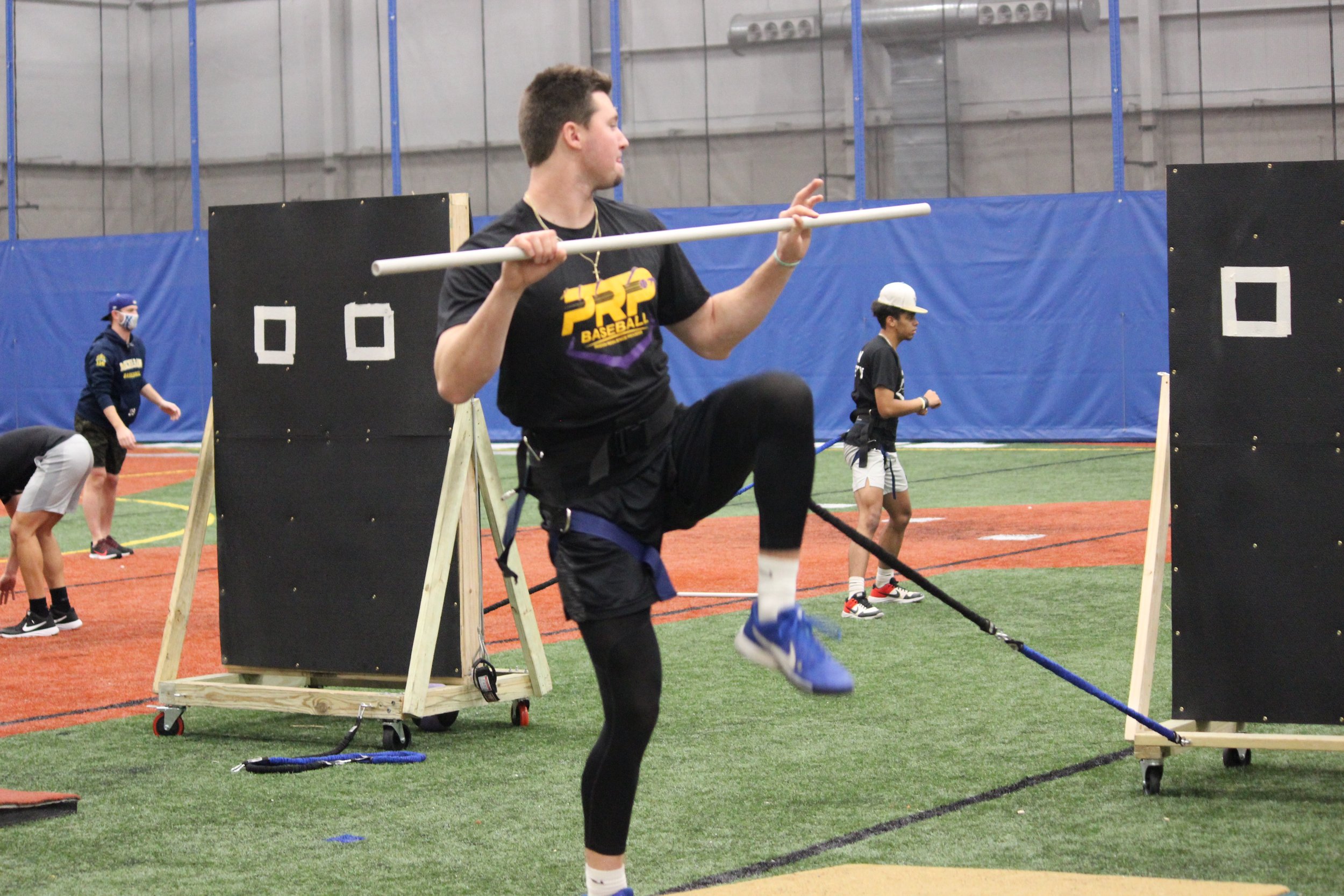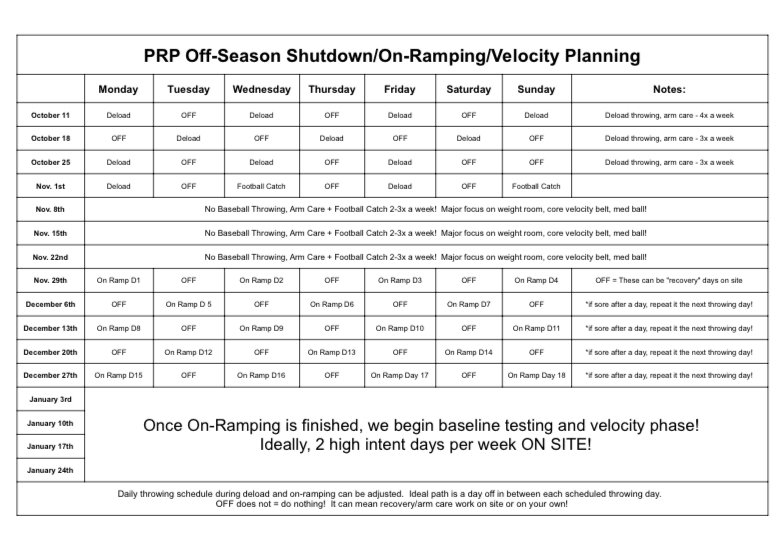Managing Throwing Shutdown and On-Ramping
Managing a Throwing Shutdown and On-Ramping Phase
Introduction
One of the most valuable components of yearly management and development is creating a calendar to manage your throwing workload. This can be viewed in 4 main phases
On-Ramping
Blending to Season
In-Season
Shutdown/Deload
The goal of this blog is to help explain and draw up potential avenues of managing each phase. The shutdown, time off, or no throwing period has several different potential routes that can and should be individualized based on the information at hand.
Factors to weigh:
Age
Workload
Length of “in-season”
Other sports
Injury history, end of year soreness
All athletes need breaks both mentally and physically. Designing a plan to strategically place your breaks and build up phases are key to long-term health and development.
Yearly Calendar
WIth the increased demand of summer and fall baseball, the throwing calendar has been extended for amateur baseball players. This often brings up the following questions:
When do I shut down? Do I even need to shut down?
How long do I shut down?
How long do I need to build back up?
How many innings is too much?
There is no clear answer to these important questions given everyone has different schedules, workloads, recovery times, and days between outings.
A standard schedule for amatuer players often look like this:
December-March = Build Up Phase
March-October (8 months) = In-Season / Managing Innings, Games
End of October-November = Shut Down / Deload / Low Volume Throwing
Some key components that need to be followed during the calendar year include adequate time between outings, consistent training in and out of season, steady build up during on-ramping, and listening to the arm throughout season.
The standard recommendation is 8-12 weeks off from throwing. This is not a bad place to start, however, being proactive during this time can be beneficial to keep conditioning valuable muscle tissue, scapular movement, and decelerators. From experience, a complete shutdown can lead to challenges during the on-ramping phase following a shut down.
Younger athletes should look to utilize longer periods of low volume and intensity throwing. A general guide can be as follows:
Ages 8-12: 16 weeks of low stress throwing or shutdown per year
Ages 12-15: 12-16 weeks of low stress throwing or shutdown per year
Ages 15-18: 8-12 weeks of low stress throwing or shutdown per year
Ages 18-22: 6-10 weeks of low stress throwing or shutdown per year
**Key variables mentioned before such as inning workload, rest time between outings, injuries, and physical maturity can easily change these suggestions!
Deload Phase
We strongly believe in a proactive shutdown phase for throwers. This means we will deload the arm with less throwing volume and intent before shutting down. This helps avoid “shocking” the system and blends us into the actual no throw period.
What does a deload mean?
A deload phase should include 2-3 light throwing days a week. This could be about 5-10 minutes of throwing up to 60-90 feet with low intensity. Distance can just but intensity should remain low. Bigger focus on pre-throw drill work, mobility, and post-throw arm care.
Plyocare or weighted balls can be implemented during this phase with lower intensities. This is a good time to work on patterning with weighted implements. Footballs should be a key part of the throwing volume throughout the deload.
Players can make up for low intensity throwing work with added stress in the weight room and medicine balls. This can help condition and build areas often undervalued during the season.
After a few weeks of deload, you can enter a “no throw” phase or maintain this deload phase of light throwing 2-3 days a week.
How do you decide if you should shut down?
This can be answered with several different answers. Ultimately, our opinion is if you think you need a break from moving your arm lightly then take it. Just be productive during this time. Keeping the arm “active” without pushing intensity or volume won’t hurt. For some athletes, it can be better to keep the arm actives so that the on-ramp phase can be an easier build up.
The specifics within programming WILL VARY based on the athlete’s needs. Some athletes will lower plyocare use, add more football or weighted ball catch, and/or change intensity during throwing in the deload.
Shutdown Phase
The deload phase has prepared us for a no-throw period. This can vary in time or if at all for different levels of throwers and workloads. To get good at throwing, we must throw. This shutdown can be used for a mental and physical break from throwing stresses.
Our shutdown phase with “no throw” still has key training programming with core velocity belt and medicine balls to improve movement quality and maintain some rotational power output.
We recommend still including pre/post throwing arm care modalities such as j-bands, rebounders, wrist weights, plyocare warm-ups, football catch, and shoulder tubing.
The weight room is KEY to this phase. Athletes should be getting multiple main lifts per week to really build strength and conditioning during this phase. Most have had a lesser workload in the weight room during season so this time becomes very valuable to build muscle tissue and physical traits.
On Ramping Phase
Our 18 day (4-5 weeks) on-ramp phase is a structured approach to increasing workload and intensity of throwing. The plan that our athletes will follow include a steadily increasing amount of plyocare pre-throw along with medicine balls and core velocity belt.
This will increase from light first day to full long toss and high intent plyo throwing before our baseline testing. There should be 1 day in between all throwing days.
General On Ramp Guide:
Week 1: 4 Throwing days with light to moderate intensity 60-90 feet for 8-12 minutes
Week 2: 3 Throwing days with moderate intensity and added volume. Around 120-150 feet
Week 3: 4 Throwing days with moderate intensity and more volume. Extension phase of long toss begins at end of week. Schedule looks like light, medium, off, light, heavy, off, light
Week 4: 4-5 throwing days with 2 long toss days and added compressions (pulldowns) at the end of throwing program.
If an athlete has soreness lasting at least 24 hours from an “On Ramp Day” then they should repeat it once they are not sore. Do this without lingering soreness before moving on to the next day.
The goal of an on-ramp phase is to prepare tissue and stressors for higher velocities and volumes of the velocity stage coming up next. Whether you are heading into a velocity phase or directly into season, a proper on-ramp is key for a healthy season.
Once this phase is complete, we will enter our baseline high-intent/velocity phase. All throwers will complete the on-ramp program all the way through before entering the next phase.
Here is an example of managing your deload, shutdown, and on-ramping phases:
Deload, Shutdown, On-Ramping Phases
Conclusion
This critical part of every thrower’s calendar year can be managed in different ways. The most important things are that you draw up the potential outlook of it, discuss it with coaches invested in your development, and listen to your arm.
Throwing for too long, through pain, and/or not giving your body a proper break can stall your development and potentially lead to injury. At PRP, we want to individualize everyone’s plan as much as possible for this time period. You can do so too by getting ahead of things and trusting the right people.
As always, email us with any questions!






